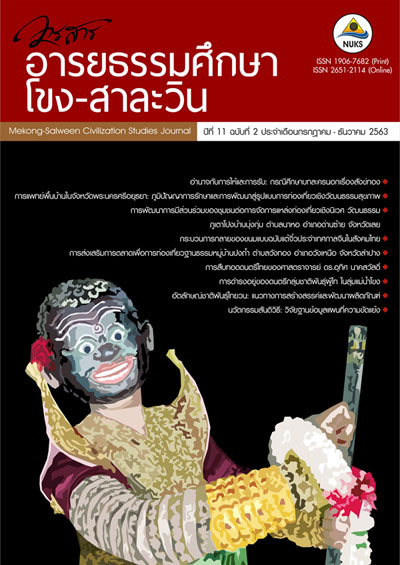The Marketing Promotion for Dhamma - Based Tourism of Ban Pong Tham Village, Wang Thong Sub – district, Wang Nuea District, Lampang Province
Main Article Content
Abstract
This research aimed to study the readiness of tourist attractions and tourist’s perception towards travel information in Dhamma-based tourism and to search for a Dhamma-based tourism marketing communication channels. For the first objective, a quantitative research method was employed. The research population and sample were 400 tourists and general people in Lampang Province. They were chosen by accidental sampling. The data were collected by using a questionnaire. For the second objective, the data were collected from 20 representatives of tourism occupational groups and experts. They were chosen by purposive sampling. The research tools were an in-depth interview and focus group discussion. The result showed that the readiness of Dhamma-based tourist attractions, analyzed according to 7 elements of service marketing principles, revealed 6 elements: product, price, marketing promotion, physical characteristics, process, and personnel. It was also found that there were 4 channels for receiving marketing promotion for Dhamma-based tourism of Pong Tham Village: 1) perception through multimedia (x̅ =2.51) , 2) perception through online websites (x̅ =2.49), 3) perception through marketing promotion and tourism programs (x̅ =2.45), and 4) perception through online social media (x̅ =2.44), respectively. In addition, it was found that a public relation through social media websites is the most suitable channel for marketing communication of Pong Tham Village’s Dhamma-based tourism.
Downloads
Article Details
References
Autthawuttikul S., Sungrugsa N., & Lakananulak S. (1975). The Model Development of Religious Tourism
Management of Ratchaburi Province. Veridian E-Journal, Silpakorn University. 10(2), 2392-2409.
Chaichatchawanprathip T., & na Thalang C. (2019). Sustainable Tourism Development to Maintain the
Destination City of HuaHin Prachuap Khirikhan Province. The Journal of Development Administration
Research. 9(2), 103-111.
Chaisri A., Srida R., & Tuphaj S. (2018). The influential factors of the marketing of Buddhism Tourism in
Chaiyaphum Province. College of Asian Scholars Journal. 8(1), 133-140.
Charoensin W., Wongmontha S., Techkana C., & na Thalang C. (2019). Marketing promotion of cultural tourism
development in Nakhon Ratchasima Province. The Journal of Development Adminis Administration
Research. 9(1), 20-32.
Cheyachanya, P. (2016). Prediction Factors of Information Sharing Via Social Media for Tourism Promotion of
Floating Market in Central Basin of Thailand. Dhurakit Pundit Communication Art Journal. 9(2), 35-60.
Department of Tourism (2018). Creative Tourism Destination Management. Bangkok: Author.
Kotler, P. (2003). Marketing Management. 11th ed. Upper Saddle River, NJ: Prentice –Hall.
Mattra C., & Buatham O. (2017). The Promothion Guideline for Buddhist Tourism Phra That Na Dun,
Na Dun District, Maha Sarakham Province. Chophayom Journal. 28(2), 57-63.
Naka T., Promsuwon S., & Wongmontha S. (2018). Marketing Communication Strategies for Tourism Promotion
in the Upper Southern Region. Journal of MCU Peace Studies. 5 (3), 290-304.
Phumiworramunee S., Wongmonta S., & Techakana J. (2019). Guidelines for the Promotion of Cultural Tourism
Marketing in Nakhon Phanom Province. Desit Thani College Journal. 13(1), 184-201.
Poltanee I., & Boonphetkaew U. (2018). Internet Use Behaviour of European Tourists Towards the Decision of
Traveling to Phuket Province. Desit Thani College Journal. 13(1), 123-138.
Puchthonglang P., Prasitbureerak P., & Puchthonglang Y. (2018). Religious Tourism Development Guidelines for
Auspicious-Name Temples in Muang District, chiang Mai Provice. Journal of Language, Religion and Culture.
(1), 212- 241.
Srisawank K., & Buaban M. (2014). The guidelines for developing integrated marketing communication to
promote tourism in Bang Luang Market and Community, Nakon Pathom Province. Journal of Management
Science. 1(2), 1-15.
Suthawan, V. (2019). Internet-Using Behavior and Satisfaction toward the Use of Internet for Travelling Purpose
of the Tourists in Tak Province. The Journal of Development Administration Research. 9(3), 66-77.
Teerawaut, A. (2000). Rewearch methodology in behavioral sciences and social sciences. Ubon Rachathani: Ubon
Ratchathani Ratchathani Rajabhat University.
Tiwasing A., Thongrom P., Kaewdang P., Sathiankomsorakrai T., & Subyuon P. (2018). Traveling Decision
Behavior and Social Media Usage of Thai Tourist. Sisaket Rajabhat University Journal. 13(3), 100-107.


